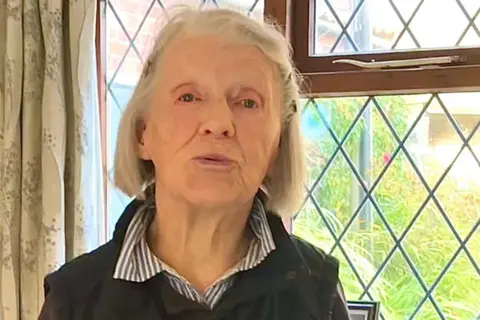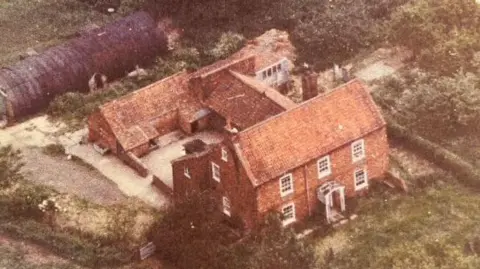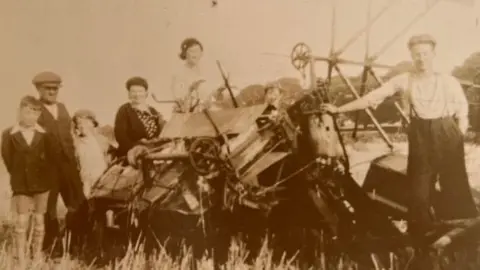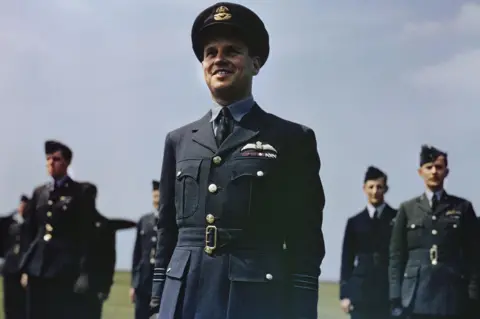The day a Dambuster dropped in for breakfast
 Getty Images/IWM
Getty Images/IWMOn a Sunday morning at the height of World War Two, 14-year-old Kit Lawie found herself sharing her breakfast table with three RAF men. At the time, she had no idea who they were – but soon one of them would be famous around the world as the leader of Operation Chastise, better known as the Dambusters raid.
Fast-forward more than 80 years and Kit, now 97, retains a vivid memory of that day.
"How much time have you got?" she smiles, as she begins to tell her story. "I've got all night if you need."
We are sitting in her small cottage in East Keal, a quiet village on the edge of the Lincolnshire Wolds and just a stone's throw from a number of RAF stations.
During the war, her family home, known as the Brickyard, was surrounded by fields and farmland owned by her father.
On that Sunday morning, Kit remembers her dad going into to the fields to count their cows.
But he ended up counting something very different.
"He came upon these three airmen in flying gear," Kit says. "They were in the wood opposite the Brickyard."

At first, her father thought they might be German spies. He was cautious.
Kit impersonates her dad's voice: "Come on out!"
The men, who were standing behind trees, did as they were told.
They explained that they were on a training exercise and had spent the night in the wood on a diet of chocolate bars.
"My father invited them in for breakfast," Kit says.
"My mother said, 'come on in, I'll do some eggs'," she laughs.
The family kitchen became a hive of curiosity. Who were these mysterious men who revealed little about themselves?
Over the table, Kit's brother, Fred, became hungry for answers and began quizzing the men.
"We can't tell you anything," came the stern reply. They were not for budging.
But the family were in no rush and kept chipping away.
 Kit Lawie
Kit Lawie"One of the three was senior because he had got wings," Kit explains.
"The others had half wings – one was an observer and the other a rear gunner."
One of the men was "much quieter" than the others.
"He didn't want them to impart any information," Kit says. "I think he was worried we were going to report him before they got back to camp, so he said very little."
Kit's father persisted, however, and this time he kept his question simple. "Who are you?"
On a piece of paper, the group wrote down their names: "Ernest Temple, David Llewellyn and G Gibson".
"Nothing else, no rank or anything," Kit says sternly.
"G Gibson" – the quiet one – was Wing Cdr Guy Gibson. He would go on to lead the Dambusters raid, but at the time Kit had no idea of his significance.
"We didn't pay attention to any of these names – they meant nothing to us at all," Kit explains.
 Kit Lawie
Kit LawieBy the time the men had finished their food, the family had found out more information.
They learned that the airmen's aim was to head west to reach the RAF station at Woodhall Spa, a further 10 miles or so away.
The family were eager to assist them as best they could and pointed to an on old map of England on the wall.
Later, as they stood on a nearby hill ready to wave them off, Kit recalls her brother asking one last question about just what it was that they were training for.
"Look at the newspapers perhaps," they were told, cryptically.
Later that day, one of the men, Ernest Temple, returned to their home.
He had borrowed an RAF bike and cycled the 10 miles from Woodhall simply to say thanks for the breakfast and their warm hospitality.
Time passed and the memory of this unexpected visit was put to one side. The paper with the names on was kept and stored in the middle of a book, a time capsule of sorts to find at a later date.
Months later, Kit and her family were listening to their old radio when the news of a daring raid was broadcast.
Finally, questions began to be answered.
 Getty Images/IWM
Getty Images/IWMOn the night of 16-17 May 1943, Lancaster bombers of 617 Squadron, which flew from RAF Scampton, near Lincoln, used "bouncing bombs" to breach the Mohne and Edersee dams in Germany.
Officially known as Operation Chastise, the Dambusters raid involved 133 aircrew in 19 Lancasters. Eight planes were lost, 53 men killed and three became prisoners of war.
Gibson survived the raid and was awarded the Victoria Cross. He died in September 1944 aged just 26, when his plane crashed in the Netherlands.
"This announcement that we'd bombed the dams, they mentioned Gibson you see," Kit says.
"And we looked at each other and said, well that's the name on the piece of paper."
"Mother fished out the piece of paper and it just said G Gibson," Kit says. "It had to be him."
More than 80 years on, Kit is not sure of the exact date of the meeting, but Gibson spent much of the war in Lincolnshire, including at Digby, Coningsby and Scampton.
And when his face appeared in several newspapers, Kit was able to reaffirm that he was indeed the mysterious visitor to their home that morning.
He had eaten with her family as they had peppered him with questions.
Everything had now fallen into place. The cloud of mystery that surrounded their breakfast guests had cleared.
These airmen were no strangers. They were part of history.
Listen to highlights from Lincolnshire on BBC Sounds, watch the latest episode of Look North or tell us about a story you think we should be covering here.
